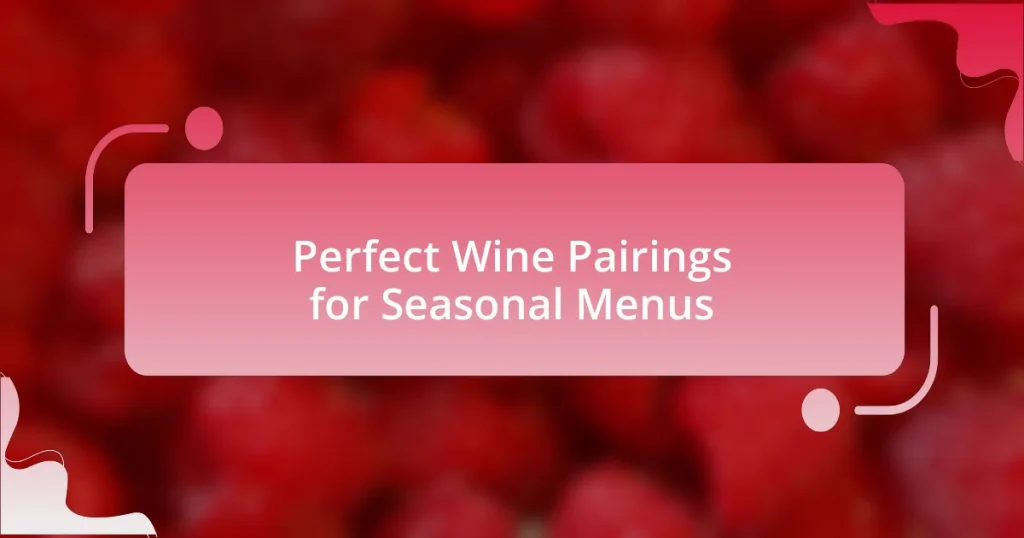The article focuses on perfect wine pairings for seasonal menus, emphasizing how specific wines can enhance the flavors of seasonal ingredients. It discusses the influence of seasonal produce on wine selection, highlighting key characteristics such as flavor profile, acidity, and body that guide pairing decisions. The article also outlines the importance of wine pairing in elevating the dining experience, detailing how contrasting and complementary flavors can enhance seasonal dishes. Additionally, it provides practical tips for creating a balanced wine list that aligns with seasonal menus, while addressing common mistakes to avoid in wine pairing.

What are Perfect Wine Pairings for Seasonal Menus?
Perfect wine pairings for seasonal menus include specific wines that complement the flavors of seasonal ingredients. For example, a crisp Sauvignon Blanc pairs well with spring dishes featuring asparagus and peas, while a light Pinot Noir enhances the flavors of summer salads and grilled chicken. In autumn, a full-bodied Chardonnay matches well with roasted vegetables and creamy soups, and during winter, a robust Cabernet Sauvignon complements hearty stews and red meats. These pairings are based on the principle that the acidity, body, and flavor profile of the wine should match the dish, enhancing the overall dining experience.
How do seasonal ingredients influence wine pairings?
Seasonal ingredients significantly influence wine pairings by enhancing the overall dining experience through complementary flavors and aromas. For instance, fresh spring vegetables like asparagus pair well with crisp white wines such as Sauvignon Blanc, which accentuates the dish’s green notes. Similarly, autumn ingredients like roasted squash harmonize with fuller-bodied wines like Chardonnay, as the wine’s richness complements the dish’s sweetness. This alignment of seasonal produce with specific wine characteristics is supported by the principle of matching acidity and body; for example, high-acid wines balance rich, fatty foods, while low-acid wines suit lighter fare. Thus, the use of seasonal ingredients not only dictates the choice of wine but also elevates the flavor profile of the meal.
What are the key characteristics of seasonal ingredients?
Seasonal ingredients are characterized by their peak freshness, optimal flavor, and availability during specific times of the year. These ingredients are often harvested at their ripest, which enhances their taste and nutritional value, making them more vibrant and appealing in culinary applications. For example, tomatoes are typically at their best in summer, while root vegetables shine in the fall and winter months. Additionally, seasonal ingredients tend to be more sustainable and environmentally friendly, as they require less energy for transportation and storage compared to out-of-season produce. This seasonal availability aligns with local farming practices, supporting regional economies and reducing carbon footprints.
How do these characteristics affect wine selection?
Characteristics such as flavor profile, acidity, tannin level, and body significantly affect wine selection for seasonal menus. For instance, a wine’s flavor profile must complement the seasonal ingredients; a rich, full-bodied red wine pairs well with hearty winter dishes, while a crisp, acidic white wine enhances lighter summer fare. Additionally, the acidity of a wine can balance the richness of a dish, making it crucial for pairing with creamy sauces or fatty meats. Tannin levels also play a role; high-tannin wines can overpower delicate flavors, so they are better suited for robust meals. These factors guide sommeliers and chefs in creating harmonious pairings that elevate the dining experience.
Why is wine pairing important for seasonal menus?
Wine pairing is important for seasonal menus because it enhances the overall dining experience by complementing the flavors of seasonal ingredients. Seasonal menus often feature fresh, local produce that has distinct flavors, and the right wine can elevate these flavors, creating a harmonious balance. For example, a crisp white wine can enhance the freshness of spring vegetables, while a robust red can complement the richness of autumn dishes. Studies have shown that proper wine pairing can increase customer satisfaction and perceived value of a meal, leading to repeat business and positive reviews.
What role does wine play in enhancing the dining experience?
Wine enhances the dining experience by complementing flavors, elevating aromas, and creating a harmonious balance between food and drink. The right wine pairing can intensify the taste of a dish, as demonstrated by studies showing that specific wines can enhance the perception of flavors in food, such as a rich red wine accentuating the umami in a steak. Additionally, wine contributes to the overall ambiance and enjoyment of a meal, as evidenced by research indicating that wine consumption can increase the pleasure derived from dining experiences.
How can wine pairings elevate seasonal flavors?
Wine pairings can elevate seasonal flavors by enhancing the taste profiles of dishes through complementary and contrasting elements. For instance, a crisp Sauvignon Blanc can highlight the freshness of spring vegetables, while a rich Cabernet Sauvignon can complement the hearty flavors of autumn stews. Studies show that the right wine can enhance the perception of flavors in food, as the interaction between the wine’s acidity, sweetness, and tannins can balance or amplify the dish’s inherent qualities. This synergy not only enriches the dining experience but also showcases the seasonal ingredients more effectively.

What factors should be considered when pairing wine with seasonal dishes?
When pairing wine with seasonal dishes, consider the flavor profile, acidity, and body of both the wine and the dish. The flavor profile should complement each other; for example, a light, crisp white wine pairs well with fresh spring vegetables, while a robust red wine suits hearty winter stews. Acidity in wine can enhance the dish’s flavors; high-acid wines work well with acidic foods like tomatoes or citrus-based dishes. Additionally, the body of the wine should match the weight of the dish; lighter wines pair with lighter dishes, and fuller-bodied wines complement richer meals. These principles are supported by the classic pairing guidelines established in culinary literature, which emphasize harmony between food and wine for an optimal dining experience.
How do flavor profiles impact wine selection?
Flavor profiles significantly impact wine selection by guiding consumers to choose wines that complement or enhance the flavors of food. For instance, a wine with high acidity, such as Sauvignon Blanc, pairs well with dishes that have rich, fatty components, as the acidity cuts through the fat, balancing the meal. Conversely, a wine with bold tannins, like Cabernet Sauvignon, is often selected for hearty meats, as the tannins soften with protein, creating a harmonious pairing. Studies show that matching flavor intensity and characteristics, such as sweetness and bitterness, between wine and food enhances the overall dining experience, making informed selections based on flavor profiles essential for achieving perfect wine pairings.
What are the common flavor profiles of seasonal dishes?
Common flavor profiles of seasonal dishes include fresh, vibrant, and often bold tastes that reflect the ingredients available during specific times of the year. For instance, spring dishes typically feature herbs, greens, and light proteins, emphasizing flavors like lemon, asparagus, and peas. Summer dishes often highlight ripe fruits, tomatoes, and grilled vegetables, showcasing sweetness and acidity. In autumn, flavors shift to earthy and warm notes, with ingredients like squash, apples, and spices such as cinnamon and nutmeg. Winter dishes tend to focus on hearty and rich flavors, incorporating root vegetables, meats, and warming spices. These profiles are influenced by the natural growing cycles of ingredients, which enhance the overall dining experience and allow for optimal wine pairings that complement these seasonal tastes.
How can contrasting or complementary flavors guide wine choices?
Contrasting or complementary flavors can significantly guide wine choices by enhancing the overall dining experience. When flavors in food and wine align, such as a rich, buttery Chardonnay with a creamy pasta dish, they create harmony, allowing each element to shine. Conversely, contrasting flavors, like a crisp Sauvignon Blanc with a rich, fatty fish, can provide balance, cutting through the richness and refreshing the palate. This principle is supported by the concept of flavor profiles, where wines are selected based on their acidity, sweetness, and body to either match or contrast the dish’s characteristics, ultimately elevating the meal.
What types of wines are best suited for different seasons?
Red wines are best suited for winter, while white wines are ideal for summer. In winter, full-bodied red wines like Cabernet Sauvignon and Syrah provide warmth and complement hearty dishes. In contrast, crisp white wines such as Sauvignon Blanc and Pinot Grigio are refreshing in summer, pairing well with lighter fare like salads and seafood. Additionally, rosé wines are versatile for spring and fall, offering a balance that suits transitional weather and a variety of foods. This seasonal pairing aligns with traditional wine consumption patterns, where heavier wines are favored in colder months and lighter wines in warmer months.
Which wines are ideal for spring menus?
Ideal wines for spring menus include Sauvignon Blanc, Pinot Grigio, and Rosé. Sauvignon Blanc, known for its crisp acidity and citrus notes, complements fresh spring vegetables and seafood dishes. Pinot Grigio offers a light, refreshing profile that pairs well with salads and light pasta. Rosé, with its fruity and floral characteristics, enhances the flavors of grilled meats and picnic fare. These wines are favored in spring due to their ability to match the season’s lighter, vibrant dishes.
What are the best wine options for summer dishes?
The best wine options for summer dishes include Sauvignon Blanc, Rosé, and Pinot Grigio. Sauvignon Blanc is known for its crisp acidity and citrus notes, making it ideal for pairing with light salads and seafood. Rosé offers a refreshing balance of fruitiness and acidity, complementing grilled vegetables and chicken dishes. Pinot Grigio, with its light body and floral aromas, pairs well with pasta salads and lighter fare. These wines enhance the flavors of summer cuisine, providing a refreshing experience during warmer months.
How do autumn flavors influence wine pairings?
Autumn flavors influence wine pairings by emphasizing rich, earthy, and spiced notes that complement seasonal dishes. For instance, wines with higher acidity, such as Pinot Noir or Chardonnay, pair well with roasted vegetables and hearty meats, enhancing the flavors of autumn ingredients like squash and mushrooms. Additionally, the presence of spices in autumn dishes, such as cinnamon and nutmeg, can be balanced by wines that have a hint of sweetness, like Riesling or Gewürztraminer, creating a harmonious dining experience. This pairing strategy is supported by the principle that the flavor profiles of wines and foods should enhance each other, leading to a more enjoyable meal.
What wines complement winter meals effectively?
Full-bodied red wines such as Cabernet Sauvignon, Merlot, and Syrah effectively complement winter meals. These wines have robust flavors and tannins that pair well with hearty dishes like stews, roasts, and rich pasta. For example, Cabernet Sauvignon’s dark fruit notes and structure enhance the flavors of beef and lamb, while Merlot’s softer profile works well with poultry and pork. Additionally, Syrah’s spiciness can elevate the taste of winter vegetables and grilled meats. Studies indicate that the warmth and complexity of these wines provide a comforting experience during colder months, making them ideal choices for winter dining.

How can one create a balanced wine list for seasonal menus?
To create a balanced wine list for seasonal menus, one should select wines that complement the flavors and ingredients of each season’s dishes. This involves analyzing the seasonal produce and culinary trends, then pairing wines that enhance the dining experience. For example, light, crisp whites like Sauvignon Blanc are ideal for spring dishes featuring fresh vegetables, while fuller-bodied reds like Cabernet Sauvignon pair well with hearty winter meals. Research indicates that food and wine pairing enhances flavor perception, making thoughtful selections crucial for a successful wine list.
What strategies can be used to curate a seasonal wine list?
To curate a seasonal wine list, focus on selecting wines that complement the seasonal ingredients and flavors of the menu. This strategy involves analyzing the seasonal produce available, such as spring vegetables or autumn fruits, and pairing them with wines that enhance their taste profiles. For instance, light, crisp whites like Sauvignon Blanc are ideal for spring dishes featuring asparagus, while robust reds like Cabernet Sauvignon pair well with hearty fall meals. Additionally, consider sourcing local wines to support regional producers and offer unique selections that reflect the local terroir. This approach not only aligns with the seasonal theme but also appeals to customers seeking authentic dining experiences.
How can local wines enhance the seasonal menu experience?
Local wines enhance the seasonal menu experience by providing unique flavor profiles that complement fresh, locally sourced ingredients. The regional characteristics of local wines, influenced by the terroir, create a harmonious pairing with seasonal dishes, elevating the overall dining experience. For example, a study by the American Journal of Enology and Viticulture found that wines produced in close proximity to the food source often exhibit flavor notes that resonate with the ingredients, enhancing taste perception and satisfaction. This synergy between local wines and seasonal menus not only supports local economies but also promotes sustainability in dining practices.
What are the benefits of including a variety of wine styles?
Including a variety of wine styles enhances the dining experience by offering diverse flavor profiles that can complement different dishes. This variety allows for better pairing with seasonal ingredients, as certain wines can elevate the flavors of specific foods, creating a more harmonious meal. For example, a crisp white wine can enhance the freshness of spring vegetables, while a robust red can complement hearty winter dishes. Research indicates that wine pairing can significantly influence taste perception, making the meal more enjoyable and memorable.
What are some common mistakes to avoid in wine pairing?
Common mistakes to avoid in wine pairing include ignoring the weight and intensity of both the food and the wine, which can lead to an unbalanced experience. For instance, pairing a light white wine with a heavy, rich dish can overshadow the wine’s flavors. Additionally, many people mistakenly pair wine solely based on the main ingredient rather than considering the overall dish, such as the cooking method and accompanying flavors. Another frequent error is overlooking the importance of acidity; a high-acid wine can enhance dishes with rich sauces, while a low-acid wine may not provide the necessary contrast. Lastly, relying on personal preference without considering traditional pairings can result in suboptimal combinations, as established pairings often arise from centuries of culinary practice.
How can over-pairing or under-pairing affect the meal?
Over-pairing or under-pairing can significantly impact the overall dining experience by either overwhelming or diminishing the flavors of the meal. Over-pairing occurs when the wine’s characteristics, such as tannins or acidity, clash with the food, leading to a disjointed taste experience. For example, a bold red wine paired with a delicate fish dish can overshadow the subtle flavors of the fish, making the meal less enjoyable. Conversely, under-pairing happens when the wine lacks the necessary complexity or body to complement the dish, resulting in a flat taste profile. For instance, a light white wine may fail to enhance a rich, creamy pasta, leaving the meal feeling unbalanced. Proper pairing is essential to elevate the meal, ensuring that both the food and wine enhance each other’s flavors.
What are the pitfalls of ignoring guest preferences?
Ignoring guest preferences can lead to decreased customer satisfaction and loyalty. When guests feel their preferences are overlooked, they may have a negative dining experience, which can result in poor reviews and reduced repeat business. Research indicates that 70% of customers are more likely to return to a restaurant that accommodates their preferences, highlighting the importance of personalization in the dining experience. Additionally, neglecting guest preferences can lead to wasted resources, as unsold menu items may accumulate if they do not align with what guests desire. This can ultimately impact a restaurant’s profitability and reputation in a competitive market.
What practical tips can enhance wine pairing for seasonal menus?
To enhance wine pairing for seasonal menus, focus on matching the wine’s characteristics with the seasonal ingredients. For example, light, crisp white wines complement fresh spring vegetables, while robust reds pair well with hearty winter dishes. Seasonal wines, such as those from local vineyards, often reflect the flavors of the region and season, making them ideal choices. Additionally, consider the acidity and sweetness of the food; high-acid wines can balance rich dishes, while sweeter wines can enhance spicy foods. This approach is supported by the principle that complementary flavors create a harmonious dining experience, as noted in wine pairing guides and culinary studies.















